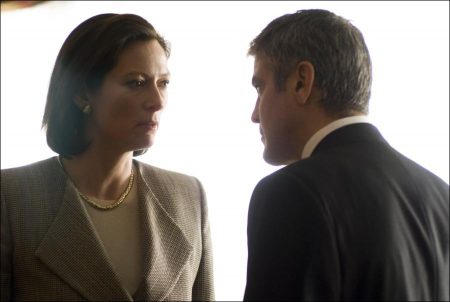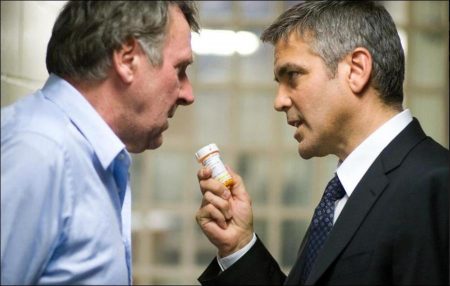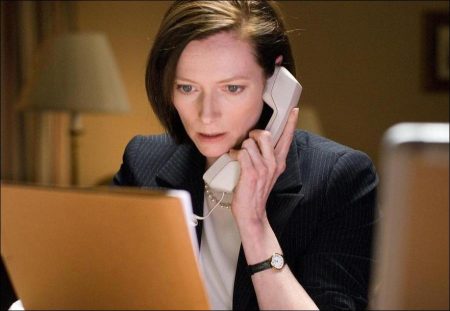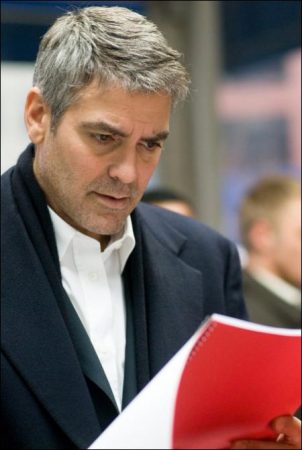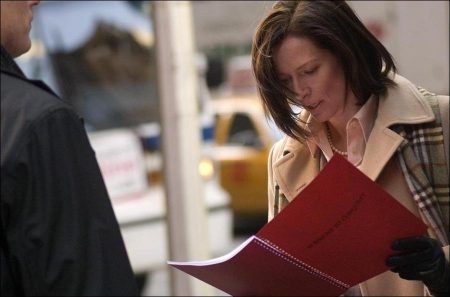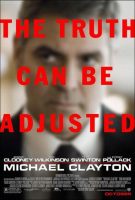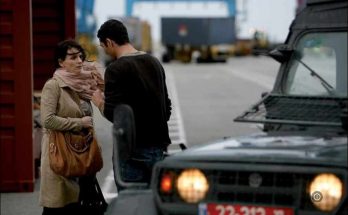The truth can be adjusted.
Michael Clayton (George Clooney) is an in-house “fixer” at one of the largest corporate law firms in New York. At the behest of the firm’s co-founder Marty Bach (Sydney Pollack), Clayton, a former prosecutor from a family of cops, takes care of Kenner, Bach & Ledeen’s dirtiest work. Clayton cleans up clients’ messes, handling anything from hit-and-runs and damaging stories in the press to shoplifting wives and crooked politicians. Though burned out and discontented in his job, Clayton is inextricably tied to the firm.
At the agrochemical company U/North, the career of in-house chief counsel Karen Crowder (Tilda Swinton) rests on the settlement of the suit that Kenner, Bach & Ledeen is leading to a seemingly successful conclusion. When the firm’s top litigator, the brilliant Arthur Edens (Tom Wilkinson), has an apparent breakdown and tries to sabotage the entire case, Marty Bach sends Michael Clayton to tackle this unprecedented disaster and, in doing so, Clayton comes face to face with the reality of who he has become.
George Clooney stars in the title role of Michael Clayton, a “fixer” at Kenner, Bach & Ledeen, a top Manhattan law firm. A former criminal prosecutor from a working-class neighborhood, Clayton is an anomaly at the white-shoe firm; in spite of his 15-year tenure, he has not been promoted to partner and probably never will be. His boss, Marty Bach, sees Clayton as an invaluable asset to the firm, but only in his “niche,” one that is relegated to cleaning up the firm’s sticky situations quickly and quietly.
“While Michael is great at solving other people’s problems, the film catches him at the apex of dissatisfaction with his career,” says Clooney, who also serves as an executive producer on the film. “He started out with ambitions of becoming a trial lawyer, but along the way what he really becomes is a bag man.”
“Michael Clayton is a 45-year-old attorney who feels that he hasn’t done everything that he could have done with his life; he’s starting to think he should have done something else, or could have done better,” says writer-director Tony Gilroy. “He’s made some bad choices and a lot of compromises. He has come to the point in life where his next few decisions will determine everything about him.
“How we make those choices—how fear, comfort, inertia and selfpreservation bend us to the wheel—that’s the fuel for the story,” offers Gilroy. In the midst of his discontentment, Michael Clayton is sent to defuse Arthur Edens, Kenner, Bach & Ledeen’s chief litigator. The defense architect for the U/North case, Arthur suddenly suffers a crisis of conscience after finding a “smoking gun” memo that exposes the client’s moral turpitude. The character is played by Oscar nominee Tom Wilkinson, who notes, “It is very much a ‘road to Damascus’ moment. Arthur’s an expert lawyer who has been at the top of his game for years, but comes to a realization that he’s been defending a cancer.”
“Given the infinity of destructive moral choices that are made every day by people who know what they’re doing is wrong, it’s always amazed me that there aren’t more whistleblowers. When you consider how much is wrong, how deep that wrong is, and how much of it’s done by people who go home and pay their taxes and love their children, isn’t it astonishing how few actually go off the deep end?” says Gilroy. “Tom’s character is one of those magnificently intelligent madmen who can convince any judge, jury or plaintiff to drop or settle a case. It’s why he’s so good at what he does and makes the kind of money he makes. But at the end of the day, what’s the real cost?”
Genesis of the Script
The original inspiration for “Michael Clayton” came to Gilroy during visits to New York law firms when he was doing research to write the screenplay of “The Devil’s Advocate.” Gilroy recalls, “Wandering through these giant New York law offices, I was struck by how much goes on behind the scenes. Every firm had vast, back-of-the-house departments running twenty-four hours a day to keep them afloat.”
In developing the script, Gilroy spent time talking to a gamut of law office personnel, including attorneys, paralegals and partners. Gilroy notes, “I heard a story about a firm involved in a huge corporate litigation that had gone on for almost a decade. The case had been essentially settled, and the firm had prevailed. The settlement was over a billion dollars. Things were so far down the line that the firm had begun clearing out the document rooms that had housed all the filings and paperwork. Two days before the final signing, at four o’clock in the morning, a third-year associate found a document that had never been placed in discovery. It was a very bad document, which would’ve meant a complete reversal of the case. The document never saw the light of day, and that associate had the fastest partner promotion in the history of the firm.”
“I wanted to know what kind of person is up at four o’clock in the morning protecting the firm,” continues Gilroy. “Who fills those gaps and makes those calls? What else do they have to do? How far could that go? What would it do to you to have that job? The answer to those questions turned into ‘Michael Clayton.’”
“Tony’s script was interesting to me right off the bat,” says producer Sydney Pollack, who was one of the early producers attracted to the project and also stars in the film as Marty Bach. “It is relevant and gets to the heart of the matter without lecturing, and it tells a story which has genuine suspense independent of moral issues.”
Gilroy emphasizes, “‘Michael Clayton’ isn’t an issue film. There’s no ideological debate. There’s no dark overlord arguing for some greater good. You’ve got a choir of fear and self-preservation on one side and the lone voice of a manic, un-medicated virtuoso on the other. Clayton represents the rest of us in the middle. What will he do?”
Producer Steven Samuels remarks, “I enjoyed Tony’s realistic approach to telling the story. It’s a reflection of our world today. The main characters in ‘Michael Clayton’ have chosen career paths that come with certain rewards and compromises. It takes tremendous courage for someone to risk losing everything in order to do the right thing.”
Cast and Characters
The Fixer
“Michael Clayton is a complicated character; he’s not a hero who always does the right thing,” says Gilroy. “All the traits that have served him so well before—his charm, his ease, his authority—none of those things are of much use to him as the story progresses. All the charisma in the world isn’t going to help you find your way home when you’re lost. Lots of actors say they want to play parts like that, but it takes a certain kind of bravery and ambition to hang your neck out there and really do it.”
“One of the things that interested me about this project was that Tony had been saving this script for himself to direct,” states George Clooney. “Tony has had much success as a screenwriter, and has been around the block enough to know what he wants. He was clearly driven to make the film, and his confidence was inspiring.”
Producer Jennifer Fox offers, “George is very believable in the part, and has that unique spark that gives Michael Clayton the ability to charm people into believing that he’ll make their problems go away.”
Gilroy remarks, “George obviously has all the chops, and he’s intelligent and charming. He can be very convincing as someone’s who’s conflicted, which made him perfect for the role.”
“My first meeting with George lasted eleven hours,” the director recalls. The two found much common ground in their affinity for 1970s cinema and spent much of their marathon meeting discussing their various influences and inspirations, overlapping decisively on such directors as Alan J. Pakula, Sydney Pollack and Sidney Lumet. “There was a certain electricity about the way films were made in the ‘70s. The characters were complex. The films were beautiful, yet they weren’t pretty. They didn’t always wrap up neatly in the end,” says Gilroy.
“It was a time of groundbreaking social progress, and filmmakers were really into reflecting that,” adds Clooney. “This movie deals with social conscience in an entertaining way. Tony’s script was written with the passion of a filmmaker, and scripts like this don’t come around very often.”
Drawing inspiration for the back story of Michael Clayton from his own personal experiences, Gilroy says, “I grew up in Washingtonville, a real copsand- firemen town on the outskirts of New York City. Every kid on my school bus had a father who was either a cop or a fireman. Michael Clayton is from a proud, working-class neighborhood where his father was a cop and his brother, Gene, is now on the force. Michael is the first male in his family who’s not a cop.”
Michael’s career choice has created distance between himself and his family. His decision to commit the last 15 years of his life to Kenner, Bach & Ledeen has begun to take its toll. He barely has time to see his 10-year-old son, of whom he shares custody with his ex-wife, and even less time to see his ailing father. Worse, Michael has a younger, alcoholic brother, Timmy, who drove their once-promising business venture into the ground and stuck Michael with an $80,000 debt, a sum he must pay in less than a week to avoid unstated consequences.
Clooney notes, “Michael’s one hope for escaping the fixer business was his walk-away money, but that’s been blown on the business with Timmy, leaving Michael with very few options.”
The Defense Architect
For the role of Arthur Edens, senior litigating partner of Kenner, Bach & Ledeen and lead defense architect for the U/North case, Clooney suggested Oscar-nominated actor Tom Wilkinson. “Tom was the first person I thought of,” says Clooney. “He has been so strong in his previous roles and was just perfect for this pivotal character.”
“Tom is an immaculate film actor,” Gilroy comments. “You need to feel Arthur’s intelligence; you need to see a momentary glimpse of his brilliance as an attorney. At the same time, I wanted the audience to approach the character with affection. Tom draws you in. Your heart goes out to Arthur.”
“Tom brought so much life to the role,” adds Pollack. “It’s not easy to tell a story about morals without coming off as self-righteous or didactic. Tom’s performance pulls you into the strangeness and the excitement of what Arthur’s experiencing, so watching his crisis of conscience is both compelling and entertaining.”
Wilkinson was attracted to the project by the subject matter and Gilroy’s writing style. “There was no question this is one of the best scripts I’d ever read,” he offers. “It’s very smartly written. What’s also interesting to me is that, like so many people, Arthur started off in the law profession fresh out of school with strong ideals and noble intentions, but years down the road he finds himself defending the indefensible and completely skewed from who he once was—all for money and preserving a way of life. He’s allowed his soul to be sullied and corrupted beyond recognition.”
Gilroy notes, “There are a lot of really decent people who do a lot of really unpleasant things every day. While it’s not difficult to empathize with people who have their entire careers invested, it is still astonishing to me the level of evil things that decent people let themselves do without saying, ‘I’ve had enough.’ On the other hand, Arthur’s had enough, and he says it in a way that no one could have anticipated.”
With a recently deceased wife and an estranged daughter, Arthur has no family and is a diagnosed manic-depressive. But as one of the firm’s best litigators, he has been ceaselessly devoted to protecting U/North for the last six years. The unintended by-product of Arthur’s life choices manifests itself in ways beyond anyone’s control, even Michael Clayton’s. The film opens with a confessional monologue from Arthur. “It’s a classic stream of consciousness speech,” states Wilkinson. “Arthur has this frenzied desire to communicate his epiphany to Michael, whom he trusts and respects.”
Arthur and Michael share a distinct bond solidified through years of working together at Kenner, Bach & Ledeen. Michael’s ability to handle crises delicately and effectively had saved Arthur from a prior breakdown eight years ago. Since then, Arthur had agreed to take prescribed medication and to go to Michael if he felt a relapse surfacing. However, this time around, Arthur skips his meds without talking to Michael and “has a total and complete breakdown, and, in effect, begins to construct a case for the other side,” says Pollack. “So the questions become: will Arthur be defused in time to save the case or will he successfully construct a case for the plaintiffs…and how will Michael Clayton fix this one?”
The Client
On the client side of the U/North case is Karen Crowder, played by awardwinning actress Tilda Swinton. Karen is an aggressively ambitious litigator who has just been promoted to the seat of U/North’s in-house chief counsel, and assumes the duty of guaranteeing a successful outcome in the class action suit.
Gilroy remarks that his goal with Karen’s character was not to make the faceless corporation the obvious villain. “I have great affection for Karen,” offers Gilroy. “Odd as it may sound, I find a way to root for her in every scene. She’s got this intense job that means everything to her. She’s barely up to speed when she’s hit with Arthur’s meltdown. And she breaks. She breaks because she’s lost. She breaks because it’s coming too fast. She breaks because she’s swamped with ambition and fear. And she breaks, ultimately, because she’s in the thrall of an illusory corporate mirage. You take that variety of poisons and lay it on someone just crippled enough emotionally to misinterpret the boundaries, and you almost have a victim.”
In casting the role, Gilroy states, “There are so many great actresses out there, but Tilda stood out in my mind. She is somebody who is strong enough to carry the extra burden of Karen’s solitary scenes. She is also very convincing in portraying someone who’s deeply flawed.”
Swinton observes, “Karen is a high-powered executive who’s overwhelmed by ambition and seduced by money and power. I think there are a lot of people in all sorts of high-level business situations who will sympathize with the kind of panic attack she has. There are three billion dollars at stake, and those sums of money can do really bad things to people’s judgment.”
Gilroy emphasizes that he specifically wrote the role for a woman to explore the role of gender in the corporate world. “For Karen, I wanted to show her desperately trying to fill the shoes of her mentor and predecessor at U/North who is older and male,” says Gilroy. “While she’s intelligent and successful, Karen wrongly approximates what she thinks male behavior is in this job.”
To prepare for the role, Swinton recalls, “I spoke to several female lawyers in very high places, and they found it very easy to understand the kind of pressure for a woman in Karen’s position. It’s a very tough line to walk, and it feels like everyone’s watching your every move, hoping you’ll falter. Karen is completely overtaken by the desire to show everyone that she can handle it. She’s so afraid of messing up and so obsessed with proving herself that she doesn’t ask for help because she fears even more the perception of being weak because she’s a woman.”
“I don’t believe that Karen is evil, per se,” says Fox. “She’s incredibly loyal to U/North, and what makes her character really interesting is that she’s just so desperate to succeed. When push comes to shove, desperate people make desperate decisions.”
The Partner
Apart from Karen Crowder, the person with perhaps the most at stake is Marty Bach, a founding partner of Kenner, Bach & Ledeen, played by Sydney Pollack.
“The character I play depends heavily on Michael Clayton to get Arthur under control,” says Pollack. “It’s Marty’s name on the door, and this incident comes at a critical time when his firm is in the midst of a merger with a company in London, which would be a lucrative buyout for him—a way to retire with a big chunk of change. So when things start going south with Arthur, Marty puts an awful lot of pressure on Michael to rein him in.”
Pollack, an Oscar-winning director and producer, had initially been developing “Michael Clayton” with Gilroy as a producer through his production company, Mirage Enterprises. Even with Pollack’s involvement as a filmmaker, Gilroy still had to do some convincing to get Pollack to agree to play the role of Marty. “I needed someone with real authority, someone who could intimidate Michael Clayton. Who better to play the head of a top New York law firm than a well-respected, award-winning director? After a lot of begging, bribing and whining, he finally said ‘yes,’” Gilroy laughs.
“When I got the call from Tony about acting in the film, I really didn’t think I had the time,” Pollack recalls. “It’s not because I don’t enjoy acting, but because it was a really busy time for us at Mirage. Still, Tony’s energy and determination was infectious so I couldn’t turn him down.”
Realm and Conquest
In contrast to the high-stakes drama among the main characters, Michael Clayton’s son, Henry, is played by 10-year-old Austin Williams. A bright and imaginative boy, Henry is an avid reader of a fictional fantasy novel called “Realm and Conquest,” which influences both Arthur and Michael in unexpected ways.
Time spent with his own son inspired Gilroy to incorporate this story element. “My son spent a great deal of his childhood obsessed with fantasy fiction. Books, cards, graphic novels, multi-player computer games—I’ve been surrounded by this stuff for years,” says the writer-director. “Some of it is brilliant. A lot of it’s repetitive. But there’s a draw to the genre that has a lot to do with the needs of the reader. There’s escapism, there are epic journeys and, more subliminally, there’s an unexpressed yearning for virtue. The fact that Henry connects over ‘Realm and Conquest’ with a bipolar attorney in the midst of a manic breakdown hopefully speaks for itself.”
As for Michael Clayton, Gilroy notes, “it’s not much of a surprise that as one’s innocence fades, the attraction to this kind of storytelling goes with it. ‘Realm and Conquest’ means a lot to Henry Clayton. Michael can’t hear it.”
Committed to a fully developed back story, Gilroy spent a good deal of time establishing the details of “Realm and Conquest” with production designer Kevin Thompson. “Right from the beginning, when I first read the script, I could tell that ‘Realm and Conquest’ was going to be a key prop. In the movie it’s a metaphor for truth and justice,” explains the production designer.
In creating the details of the fictional novel, Thompson generated original visuals inspired by German Expressionistic images cut from wood blocks, and Gilroy wrote the first two pages for three chapters of the book. They even went as far as designing a “Realm and Conquest” card game for a scene between Henry and Michael. Thompson offers, “This detail was important to Tony because, in his own life, novels and games similar to ‘Realm and Conquest’ allow him to connect with his son in a meaningful way.”
Writer and Director
Having enjoyed success as a screenwriter, Gilroy stepped up to the challenges of directing his first feature film, including the formidable task of working with a main cast of seasoned actors, two of whom are acclaimed directors.
Clooney, who made his feature directorial debut in 2002 with “Confessions of a Dangerous Mind,” knows what it takes to successfully cross over from another focus into directing. He says, “As a director, you’re the general. You’ve got to be smart enough and convincing enough to make everyone believe in you. The very first minute Tony walked in the office, I thought, ‘I like this guy and I think he’s smart. Most important, he knows what he wants.’ Tony was not afraid to make decisions on his own.”
Pollack notes, “Sometimes it’s better to work with a director who’s not the writer and other times it’s better to work with a director who is the writer. It’s difficult when writers don’t have the objectivity about their own work. With Tony, he’s very comfortable and confident and has none of the timidity and confusion that first time directors often have. There’s something quite seasoned about Tony’s approach.”
Samuels adds, “Tony just exudes confidence. He really does. You can see it in his eyes. But he’s honest about where he is, what he knows and what he doesn’t know. Above all, he is not afraid to push new boundaries for himself.” Behind the positive first impressions, Gilroy admits, “The thought of directing my first feature with such a high-caliber team was intimidating.
Fortunately, I’ve had great support from a group I really trusted and relied on. Everyone from George and Tom to Sydney and Tilda; from Jennifer, Steven and Kerry to Robert Elswit, Kevin Thompson and my brother, John Gilroy; there was so much brain power and talent on this project that there wasn’t much room for fear.”
Town and Country
Principal photography on “Michael Clayton” began in January 2006 in New York City. “It’s very, very ambitious to make a movie in the middle of winter in New York. We had 71 locations, and had to be very lucky with the weather. Fortunately, we were. We had an extremely detailed prep complemented with a very nimble crew,” says Gilroy. As many of the world’s top law firms have offices in New York City, Gilroy envisioned shooting the film amidst the boxy skyscrapers that line a main artery in midtown Manhattan: Avenue of the Americas, otherwise known as Sixth Avenue. “A building boom in the 1960s and 1970s gave birth to an environment of 50-story international-style glass boxes lined up one after another,” notes Gilroy. “The buildings are stacked in such a beautiful, horrifying kind of way.”
“When you start doing research into the big law firms, it’s amazing to discover how massive they are, how they’re complete worlds unto themselves,” states production designer Kevin Thompson. “People go into the office and rarely leave during the course of the day and into the night. All their meals are catered, and they only go home to sleep and shower. We wanted to show how law firm life can become a parallel universe, and how that disconnect could foster insular thinking and corrupt ideals.”
The filmmakers agreed early on to shoot most of the film on location. After scouting the offices of several law firms, the filmmakers ended up combining shots from three different offices.
For the conference room scenes in the beginning and the end of the film, Gilroy chose the offices of Dewey Ballantine, one of the oldest and most respected practices headquartered in New York City. Located in midtown Manhattan’s Corporate Row, the office houses 300 attorneys and has a grand conference room that spans the entire Sixth Avenue side of the building’s 22nd floor, with views in three directions.
Marty Bach’s office was filmed in the same building as Dewey Ballantine but on a different floor, in an office of financial company Oaktree Capital Management. “We specifically chose an office on a higher floor with a dramatic view of Central Park to convey the power of Marty Bach’s position,” explains Jennifer Fox.
The exterior scenes for Arthur’s loft were shot in Tribeca, while the interior scenes were shot in a raw space in Little Italy. “It was always Tony’s idea to imply that Arthur used to live on the Upper East Side, but that his life fell apart after his wife died,” says Thompson. “He tried to start anew by moving and changing neighborhoods, so he bought this huge, palatial raw space loft, but hasn’t ever really settled in. He probably intended to renovate the space at some point but became so involved in the U/North case that he never really got it together, so the loft looks almost decayed. We tried to connect the dilapidated, castle-like look of the loft with the visual imagery in the ‘Realm and Conquest’ book.”
For scenes that contrasted with Manhattan’s urban setting, the production moved from New York City to upstate New York. “We looked for landscapes that were wild and bucolic,” notes Thompson.
“There’s a scene in a field that plays twice in the film. It’s a big moment in the story, so it was important to find the perfect location,” Gilroy recalls. “At the height of the search, my brother was upstate visiting our parents and, on impulse, I had him take his cell phone and grab a couple shots of a place up the road from where we grew up. It’s this gorgeous valley, bisected with a very dramatic, hundred-year-old cast iron train trestle. It was a mythic high school hangout and it was still there.
“Twenty-four hours later we were up there with a dozen people trying to figure out how we could afford to shoot that far from the city for five days,” continues Gilroy. “The answer was to move the company upstate for a week and bundle a couple other locations into the trip. The punch line is we ended up shooting the house where Michael Clayton grew up in the house where I envisioned Michael Clayton growing up, which is where I grew up. And believe me, you haven’t experienced surreal until you’ve brought George Clooney and a movie crew back to your childhood neighborhood.”
Michael Clayton (2007)
Directed by: Tony Gilroy
Oyuncular George Clooney, Tom Wilkinson, Tilda Swinton, Sydney Pollack, Michael O’Keefe, Austin Williams, Pamela Gray, Alberto Vazquez, Julie White, Jennifer Van Dyck
Screenplay by: Tony Gilroy
Production Design by: Kevin Thompson
Cinematography by: Robert Elswit
Film Editing by: John Gilroy
Costume Design by: Sarah Edwards
Set Decoration by: Paul Cheponis, George DeTitta Jr., Christine Mayer, Chuck Potter
Art Direction by: Clay Brown
Music by: James Newton Howard
MPAA Rating: R for language including some sexual dialogue.
Distributed by: Warner Bros. Pictures
Release Date: October 12, 2007
Views: 77
